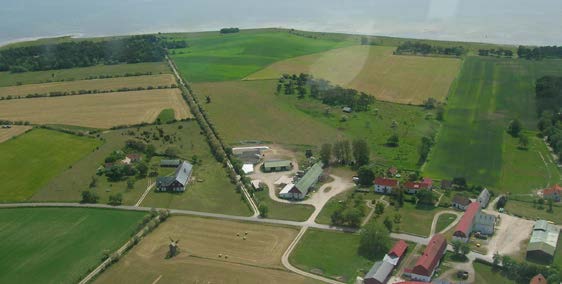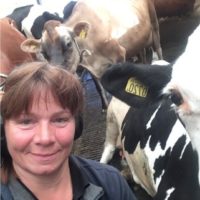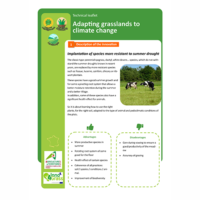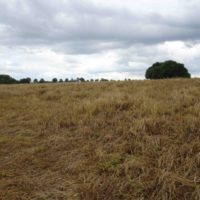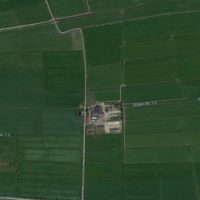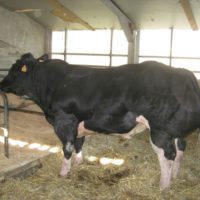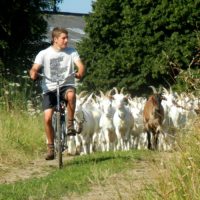Irrigation and slurry are important resources in dry areas
Farm: “Siglajvs”
Location: Gotland, Sweden
Case study
 Irrigation and slurry are important resources in dry areas (.pdf)
Irrigation and slurry are important resources in dry areas (.pdf)
Description
Background
Siglajvs Farm lies in När in southern Gotland and has 50 dairy cows. It has been producing organic milk since 2009. The aims are to make best use of the farm’s resources, to produce food in an environmentally friendly way and to achieve large production from cows, grassland and pastures. The organic cows on the farm produce as much milk as conventional cows, with yield of around 11000 kg per cow and year. The extremely hot, dry weather in spring 2018 had an effect on the farm and temporarily decreased the level of milk production. Gotland is a limestone-rich island and has annual rainfall of only 500 mm per year, making it one of the driest parts of Sweden. Another major problem for farmers on the island is the high population of barnacle geese, which graze the fields in the spring and severely reduce grass growth.
Detailed description
Siglajvs Farm lies in an agricultural area, but the entire island of Gotland has a high level of tourism, particularly in summer. This can affect how agriculture is developed and expanded. When Siglajvs Farm was converting to organic milk production, the dry climate was considered to be a major risk. The farm lies very close to the Baltic Sea, which has a relatively low salt content, and in the past the water was used to irrigate sugar beets and meadows. However, problems arose with this irrigation, while tractor-driven irrigation pumps were too expensive. Therefore, together with another farm, Siglajvs Farm designed and built a 16 ha irrigation dam, which was completed in 2006. Water is pumped into the dam in autumn, winter and spring from a canal draining 35 km² of arable land. The intention is for nitrogen and phosphorus to sediment in the dam, thereby reducing the nutrient load reaching the Baltic Sea.
Siglajvs Farm wanted to achieve more, however. Thus in 2009 they applied for a grant for an irrigation company, Närstream, which was created by three farms. It has installed 40 km of irrigation pipe, e.g. to a nearby golf course that also needs water. Two pumps maintain the pressure in the pipes and in the high season eight irrigation machines and the golf course’s irrigation system are in use. The irrigation company has three irrigation machines and Siglajvs Farm also owns one. Apart from irrigating the farms’ own land, Närstream sells irrigation services to other farmers. A lot of potatoes are grown on Gotland, often in dry periods, so potato growers need to have access to irrigation. Siglajvs Farm waters its own grassland early in the season and is therefore able to sell irrigation to its neighbours later on. At home, they often water the grassland a week before the first silage cut, which is taken at the end of May, to ensure that the grass can start regrowth quickly after cutting. They often apply 20 ton/ha slurry after the cut, and then 20–25 mm of irrigation.
Another environmental measure taken on the farm was to build an extra slurry lagoon with a roof. This means that they can store the slurry for spreading in spring and summer and get better nutrient utilisation and larger yield. The roof prevents rainwater entering and diluting the slurry, which decreases the volume that needs to be spread.
Barnacle geese are a protected species on Gotland. Culling is only allowed in spring and only five geese may be shot on the farm. However, the geese are present in their thousands and graze and foul the grassland. Through observation, Siglajvs Farm has identified grass and legume species that the geese prefer/avoid. Thus the conventional cocksfoot has been replaced by tall fescue hybrids, while among the legumes lucerne has been found to be least grazed by the geese. However, it is also considered important to include other species, apart from grasses and legumes, in the sward. Of these, caraway copes best with the geese. The county council has helped with the cost of forage analyses for the different seed mixtures.
Another important strategy as regards feeding on Siglajvs Farm is to grow as much protein feed as possible. They now grow a vetch-spring wheat mix for whole-crop silage. This gives more protein than the pea-oats mix that was grown previously. The protein mix crop is sown in spring, together with an undersown grass ley. By the end of July, the vetch has developed sufficiently and the wheat has reached the milk development stage. The crop is then cut with a mower conditioner and harvested with ordinary grassland machinery. The ley continues to develop afterwards.
Apart from the dairy cows, Siglajvs Farm also has 50 ewes of the Gotland breed. The farm’s natural pastures are grazed by these sheep and by calves in alternate years. This results in parasite-free grazing, so no worming treatments are needed for the animals. In winter, the heifers get the feed that the sheep separate out, since they are more selective in their feeding. This means that there is no loss of feed.
Results
Since Siglajvs Farm collaborates with its neighbours, the yield of the different farms can be compared. In the first cut, Siglajvs Farm’s organic leys give the same yield as the conventional leys of neighbouring farms. However, yield is lower in the other cuts.
The change to storing slurry under cover reduced the spreading costs by 500 Euro per year.
With the new forage seed mixtures that are less attractive to barnacle geese, it has been found that the harvesting window is narrower. In both lucerne and tall fescue, the nutrient content decreases rapidly if the crop is not cut often enough. Fortunately, these species have a similar development rhythm and are therefore a suitable combination. They are also tolerant to drought, since they are both deep-rooting. The herbs included in the sward, currently caraway, chicory and pimpernel, also have a well-developed root system. Ribwort plantain is not as deep-rooting, but appears to be very tolerant to drought.
Siglajvs Farm has chosen to use its existing buildings and land to the optimum, since the alternative of increasing its area and herd size is not realistic. When the farm converted to organic, milk yield decreased by 1000 kg per cow, but is now around 11000 kg per cow and year. Conversion to organic brought other benefits: less concentrate, more forage and positive effects with healthier cows.
Adoption criteria
Year 2018 was one of the driest years in Swedish history. Many farms are now considering creating irrigation ponds or dams so that they can water their crops in future dry years. Collaborating with neighbouring farmers to create an irrigation company also brings benefits to others in the community and a large environmental dam collects leached nutrients that would otherwise be transported along drains to the Baltic Sea. It is both financially and environmentally sound to retain as much nutrients as possible on the farm, by e.g. building a roof over the slurry lagoon and only spreading slurry in spring or summer, when growing plants can take up the nutrients. This also increases the yield of the crops. Testing which crops are best suited to the specific farm is important for success. On Siglajvs Farm, this has led to use of a vetch-winter wheat mixture for production of protein-rich whole-crop silage. The farm has also adjusted its seed mixture composition to reduce damage by grazing barnacle geese.
Future prospects
The investments made on the farm were partly funded by grants. However, such grants come with a range of conditions and there is a risk of non-payment if these are not fulfilled. In addition, the application process is demanding for the farmer, but at the same time the amounts of capital involved are great and the grants are important.
Last year, Siglajvs Farm tested drilling cereals with GPS. This meant that they could carry out an extra hoeing to control weeds. The results were good and, despite the dry summer, the yield was 3.5 ton per ha. The farm intends to continue with this system. By working with a holistic approach, the aim is to continue improving the environmental profile of the farm.
Additional information
| Farming system | organic farming |
|---|---|
| Domains of innovation | forage mixture, machinery, tools |
| Main types of animal | dairy cattle |
| Country | Sweden |
| Product type | Case study |
| Language | English |
| Author | Anna Carlsson |

